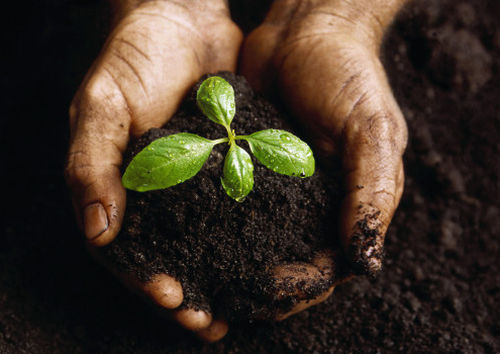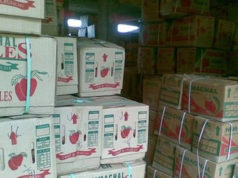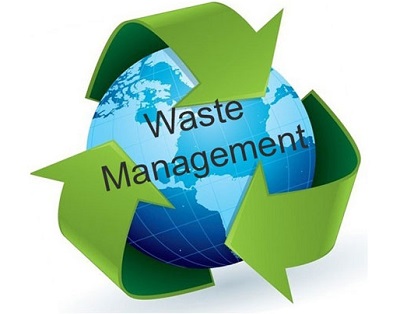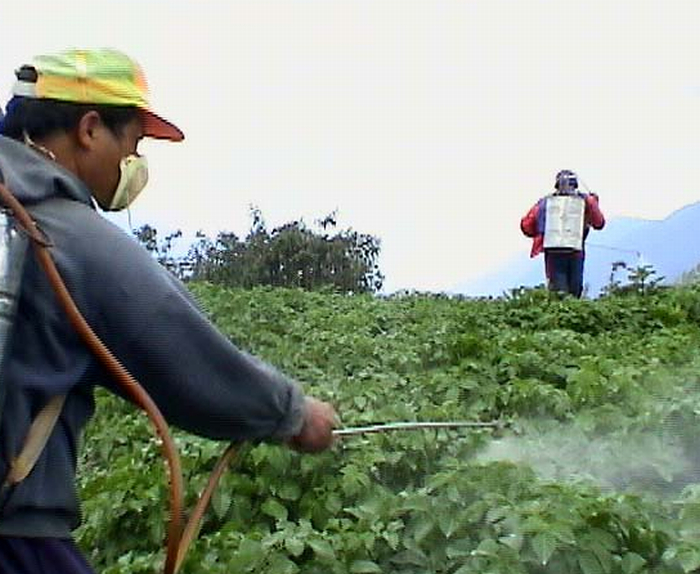
You’ll often read or usually get an advice, but many of us do get the recommendation to check soil pH, but what does it really mean? Technically, pH is a gauge of the hydrogen-ion concentration in the soil, pH is simply a measure of how acid or alkaline a substance is, and soil acidity or alkalinity (soil pH) is important because it influences how easily plants can take up nutrients from the soil. Many organic/synthetic fertilizer manufacturers, plant sellers and many catalogs list the preferred pH for specific plants. The good news for gardeners is that, with a few exceptions, most plants will tolerate a fairly wide range of soil pH, which is measured on a scale of 1-14, with 7 as the neutral mark, anything below 7 considered acidic soils and anything above 7 considered alkaline soil. For the gardener’s needs, it is enough to know whether your soil is alkaline or acid because certain nutrients can only be accessed by plants when the soil pH falls into an acceptable range. Most plants prefer a somewhat neutral pH, anything from 6.2 to 7.0. However there are many plants that are more specific in their pH needs, such as blueberries which like a very acidic soil and a few others that prefer a more alkaline soil. As in layman language acid soils are often referred to as “sour” and alkaline soils “sweet”.
Nutrient uptake by roots and soil pH: Plant roots absorb mineral nutrients such as nitrogen and iron when they are dissolved in water. If the soil (the mixture of water and nutrients in the soil) is too acid or alkaline, some nutrients won’t dissolve easily, so they won’t be available for uptake by the roots. Which can cause the deficiency of nutrient in the plant and can cause normal growth and can affect the overall health of the plant? Most nutrients that plants need can dissolve easily when the pH of the soil solution ranges from 6.0 to 7.5. Below pH 6.0, some nutrients, such as nitrogen, phosphorus, and potassium, are less available. When the pH exceeds 7.5, iron, manganese, and phosphorus are less available.
pH Affects Nutrients, Minerals and Growth
The effect of soil pH is greater on the solubility of minerals or nutrients. Before a nutrient can be used by plants it must be dissolved in the soil solution. Most minerals and nutrients are more soluble or available in acid soils than in neutral or slightly alkaline soils. Phosphorus is never readily soluble in the soil but is most available in soil with a pH range centered around 6.5. Extremely and strongly acid soils (pH 4.0-5.0) can have high concentrations of soluble aluminum, iron and manganese which may be toxic to the growth of some plants. A pH range of approximately 6 to 7 promotes the most ready availability of plant nutrients. But some plants, such as azaleas, rhododendrons, blueberries, white potatoes and conifer trees, tolerate strong acid soils and grow well. Also, some plants do well only in slightly acid to moderately alkaline soils. However, a slightly alkaline (pH 7.4-7.8) or higher pH soil can cause a problem with the availability of iron to pin oak and a few other trees in Central New York causing chlorosis of the leaves which will put the tree under stress leading to tree decline and eventual mortality.
The soil pH can also influence plant growth by its effect on activity of beneficial microorganisms Bacteria that decompose soil organic matter are hindered in strong acid soils. This prevents organic matter from breaking down, resulting in an accumulation of organic matter and the tie up of nutrients, particularly nitrogen, that are held in the organic matter.
Changes in Soil pH
Soils tend to become acidic as a result of:
(1) Rainwater leaching away basic ions (calcium, magnesium, potassium and sodium).
(2) Carbon dioxide from decomposing organic matter and root respiration dissolving in soil water to form a weak organic acid.
(3) The formation of strong organic and inorganic acids, such as nitric and sulfuric acid, from decaying organic matter and oxidation of ammonium and sulfur fertilizers.
Strongly acid soils are usually the result of the action of these strong organic and inorganic acids. Lime is usually added to acid soils to increase soil pH. The addition of lime not only replaces hydrogen ions and raises soil pH, thereby eliminating most major problems associated with acid soils but it also provides two nutrients, calcium and magnesium to the soil. Lime also makes phosphorus that is added to the soil more available for plant growth and increases the availability of nitrogen by hastening the decomposition of organic matter. Liming materials are relatively inexpensive, comparatively mild to handle and leave no objectionable residues in the soil.
Some common liming materials are:
(1) Calcic limestone which is ground limestone;
(2) Dolomitic limestone from ground limestone high in magnesium; and
(3) Miscellaneous sources such as wood ashes.
The amount of lime to apply to correct a soil acidity problem is affected by a number of factors, including soil pH, texture (amount of sand, silt and clay), structure, and amount of organic matter. In addition to soil variables the crops or plants to be grown influence the amount of lime needed.
In addition to monitoring soil pH the nutrient status of the soil should be examined.
Correcting acid soil: If your soil is too acid, you must add alkaline material, a process commonly called liming. The most common liming material is ground limestone.
There are two types: calcitic limestone (calcium carbonate) and dolomitic limestone (calcium-magnesium carbonate). In most instances, you’ll use calcitic lime. Apply dolomitic lime only if your soil also has a magnesium deficiency.
Ground limestone breaks down slowly in the soil. Apply it to the garden and lawn in the autumn to allow time for it to act on soil pH before the next growing season. A rule of thumb for slightly acidic soils is to apply 5 pounds of lime per 100 square feet to raise pH by one point. In general, sandy soils will need less limestone to change pH; clay soils will need more. The amount of lime you must add to correct pH depends not only on your soil type but also on its initial pH. For example, applying 5 pounds 464of limestone per 100 square feet will raise the pH of a sandy loam soil from 6.0 to 6.5. It would take 10 pounds per 100 square feet to make the same change in silty loam soil. However, if 5.6 was the initial pH of the soil, 8 pounds per 100 square feet would be required for the sandy loam soil, and 16 pounds per 100 square feet of the silty loam soil. There is no simple rule of thumb that applies to all soils. The safest approach to take if you plan to apply limestone is to have your soil tested and follow the lab recommendations. Applying wood ashes also will raise soil pH. Wood ashes contain up to 70 percent calcium carbonate, as well as potassium, phosphorus, and many trace minerals. Because it has a very fine particle size, wood ash is a fast-acting liming material. Use it with caution, because overplaying it can create serious soil imbalances. Limit applications to 11 kg’s per 1,000 square feet, and apply ashes only once every 2 to 3 years in any particular area. At this rate, your soil will get the benefits of the trace minerals without adverse effects on pH.
Correcting alkaline soil: Alkaline soils are usually found in chalky or limestone areas or where there’s builder’s rubble in the soil. Plant roots have difficulty penetrating alkaline soils (especially trees) due to the pockets of solid chalk or limestone rock. During dry periods, only a limited amount of water can be held and the soil becomes extremely dry due to the soil consistency. Once plants are established however, they can grow a deep root system allowing them to absorb the maximum amount of water.
Improve the Organic Content: There is a wide range of plants that you can grow in alkaline soil but if you want to grow even more species you’ll need to improve the organic content of the soil. To do this (after a period of rain) adds large amounts of leaf mould, well-rotted manure or garden compost. Dried blood can also help improve the nutrient levels. Using a fork, break up the top layer of soil to help roots develop more easily before planting.
If your soil is too alkaline, add a source of acidity. The most common material to add is powdered elemental sulfur. As a rule of thumb, add 1 pound of sulfur per 100 square feet to lower pH 1 point. But as with lime, the correct amount will depend on your soil type and its initial pH. Testing your soil and following lab recommendations is the best approach if you want to lower the pH of an entire bed or an area of your yard. Mixing peat moss with the soil will also lower pH, but peat moss is not a sustainable resource and has been over harvested in many areas; incorporating ample organic matter (such as shredded leaves) is a more environmentally friendly option.
Benefits of Soil Testing
Soil pH (Acidity Test): If the soil is too acidic, aluminum is dissolved causing a specific ion toxicity. The plant growth is stunted and the leaf coloration is sometimes deep green. If the soil is too alkaline, some plant nutrients are unavailable causing a mineral deficiency. The source of these two problems can be the use of too much plant fertilizer of the incorrect type. Soil acidity (pH test) is required to know the soil acidity status. Managing alteration in soil acidity with choice of nitrogen fertilizers – Fertilizer products are not interchangeable. Each product has a particular advantage and benefit over other materials. Use of the incorrect product will exacerbate problems while the correct one will enhance growth. For instance with nitrogen products, ammonium sulfate (21-0-0) will acidify the soil; ammonium nitrate (34-0-0) will be pH neutral if not over applied; calcium nitrate (15.5-0-0) will slightly increase the soil pH; urea (46-0-0) needs to be hydrolyzed before it is available. Nitrate nitrogen will supply soil oxygen. Ammonium nitrogen consumes oxygen when it is nitrified to nitrate. Slow-release nitrogen materials also have certain benefits. Urea formaldehyde (38-0-0) release nitrogen according to temperature and biological activities
Presence of limestone: ¬ If limestone (calcium carbonate or chalk) is present, acid-loving plants become iron deficient unless corrective measures are taken.
Lime Requirement: In areas of high rainfall, there are inadequate levels of potassium, calcium and/or magnesium due to the acidic soil. Tests for the required level of limestone or dolomite needed to raise the soil pH to a safe level are essential.
Excess Salts in the Soil: If salts excessively accumulate in the soil, many plants are unable to use the moisture in the soil and may have a toxicity of sodium and/or chloride. A salinity test (the term used by laboratories is salinity) is required to determine if this is a problem. The salinity can be controlled by leaching unless soils have drainage problems. A soil high in salinity is called “saline.”
Excessive Sodium: Excessive sodium or a “sodic” soil most often has an elevated pH level. Soils high in pH values are suspect. Sodium can cause toxicity, but the more likely problem is soil compaction and poor drainage caused by the reaction of sodium on the clay.
Gypsum Requirement : Excessive sodium can be corrected with the addition of gypsum. Another cause of high pH values is the presence of bicarbonates. Gypsum is also used to precipitate the excessive bicarbonates and lower the very high soil pH values. A soil test shows how much gypsum is needed.
Fertility: Most plants require at least 16 nutrients. Three nutrients are supplied by the water and by the air (oxygen, hydrogen and carbon). Thirteen is mineral nutrients. If anyone is too low, the plants will not grow. In some cases, too much fertilizer has been applied causing an adverse reaction. Overdose of phosphorus, for instance, inhibits the plant uptake of iron, manganese, zinc and copper causing induced deficiencies. The best method to determine if a problem is caused by a true deficiency or is an induced deficiency is soil testing. Soil analysis is used to assess the nutrient levels of the soil. Plant tissue testing is also used to ascertain which nutrients have reduced availability in the soil.
Toxicity : Soils may contain toxic metals. They either exist in the soil naturally or have been introduced as contaminants in amendments. Mined minerals and waste products are the frequent contaminant sources. These elements prevent plant growth. If a vegetable garden is to be grown and if the presence of heavy metals is suspected, the soil should be tested as a precaution for human poisoning. Lead can be present in urban soil at levels which do not injure plants but can accumulate in produce at levels which may harm humans. Excess levels of selenium and molybdenum are problems with wildlife or cattle. Other common toxic elements are aluminum, cadmium, chromium, nickel, arsenic, silver, and vanadium.
Soil Compaction: ¬ Excessive compaction impedes root growth, impairs water penetration and reduces soil aeration. Reduced aeration hinders the absorption of nutrients. In addition, slow water penetration exasperates the problem. Soil compaction can be measured and corrected with soil conditioners. Their need can be detected by soil testing.













